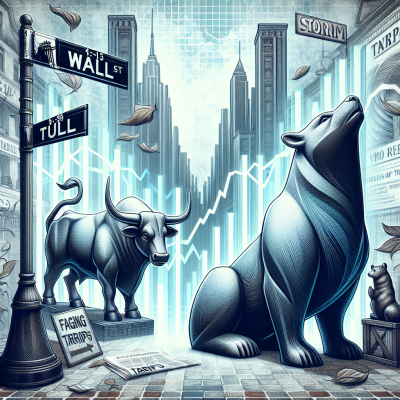
Wall Street Reacts to Tariff Shockwaves
U.S. stock futures took a sharp dip early Tuesday morning following news that former President Donald Trump intends to reinstate steep tariffs on Chinese imports if elected in the upcoming 2024 presidential elections. The development has reignited investor anxieties surrounding global trade tensions and their potential to hamper economic growth.
Markets responded almost immediately, with futures for the Dow Jones Industrial Average dropping by more than 200 points, while the S&P 500 and Nasdaq Composite also registered notable declines. The news comes amid already fragile market sentiment, with inflation, interest rates, and recession fears looming in the background.
Tariff Plan Creates Uncertainty for Investors
Trump’s proposal to reinstate tariffs on Chinese imports—potentially as high as 60%—has sent a ripple of apprehension through Wall Street. His statements suggested a renewed focus on economic nationalism, a return to the policies that defined much of his first term in office.
The potential for a new era of aggressive trade policy has investors reevaluating risk. According to analysts, the heightened uncertainty could lead to reduced business investment and slower global trade—factors that tend to undermine corporate profits and investor confidence.
Key concerns include:
- Disrupted supply chains and increased manufacturing costs
- Higher consumer prices and downward pressure on consumer spending
- Reduced international market access for U.S. companies
Sector-Specific Repercussions
The tech sector—already under pressure from tightening regulations and high valuations—was among the hardest hit. Many tech companies heavily rely on components and assembly from Chinese suppliers, making them particularly vulnerable to intensified U.S.-China trade tensions.
Similarly, the auto industry and consumer goods manufacturers could face margin squeezes if material costs rise due to tariffs. With labor and transportation costs already escalating, these sectors may find it difficult to absorb the impact of additional trade barriers.
Financial Sector Shows Mixed Reactions
Interestingly, big banks and financial institutions demonstrated a more mixed response. On one hand, increased volatility often leads to higher trading volumes and profits for investment banks. On the other hand, prolonged uncertainty and geopolitical instability are generally negative for sustained economic growth and financial market performance.
Analysts Urge Caution and Diversification
Leading market strategists are advising investors to take a cautious approach in the near-term. With Trump’s policy direction becoming clearer as the election approaches, the market could experience heightened volatility.
Recommended strategies include:
- Diversification: Spreading investments across different sectors and geographies to reduce risk exposure.
- Safe Haven Assets: Increasing allocation to gold, bonds, and dividend-paying stocks to weather potential market downturns.
- Monitoring Policy Developments: Staying informed about political sentiments and potential legislative changes that could impact stock performance.
Global Implications Still Unfolding
China has yet to respond formally to Trump’s tariff plans, but analysts expect retaliation if the proposals gain traction. A tit-for-tat trade war could further destabilize a global economy already struggling with inflation and slowing growth.
The news also comes as U.S. trade allies assess their own economic policies amid rising protectionist sentiments globally. If the protectionist wave gains momentum, it could mark a significant shift away from the globalization era that previously fueled unprecedented economic expansion.
Conclusion: Market Bracing for a New Trade Era
As Trump tariffs once again take center stage in political and economic discussions, the marketplace is clearly on edge. While nothing is set in stone until post-election policy is implemented, the possibility of renewed trade tensions has already planted seeds of uncertainty in Wall Street.
For investors and economists alike, the coming months will be critical. Watching how markets, corporations, and global partners respond to these evolving trade dynamics will offer deeper insight into what’s next for the U.S. economy and the future of international commerce.
Stay tuned as more details unfold—and prepare for a potentially bumpy ride in the markets ahead.


Leave a Reply